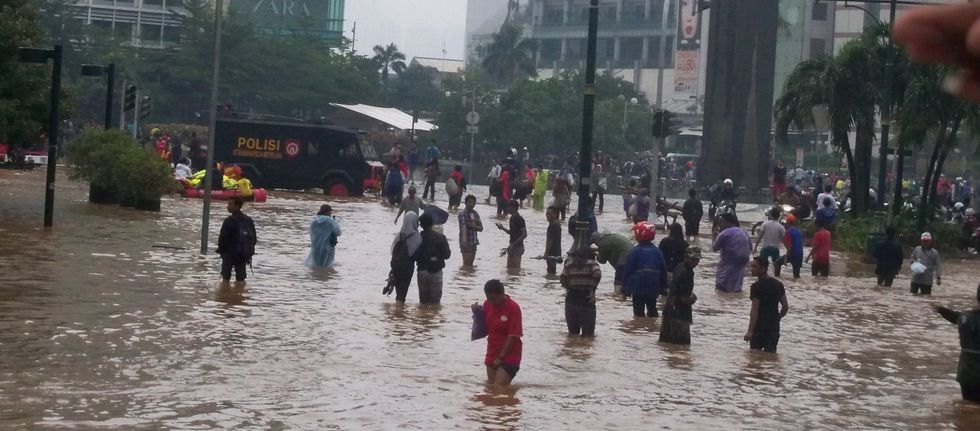As the world turns its calendars to 2020, Jakarta is celebrating the new decade looking like a city-wide waterpark as chocolate-colored water flows through the streets.
On the morning of January 1, my friend witnessed a lady exit her car, sit on the floor in the middle of a rainstorm, wash her hair with shampoo, wash her pants with soap, and finally get escorted off the property because apparently the house she parked in front of was not hers.
My mom, an avid Twitter browser, found memes of people "farming tadpoles" in their house because it has now transformed into a giant pond.
Another friend of mine duct-taped her door in preparation for the rising water with hopes that it will magically waterproof her house. This friend's home state pinned the problem of flooding on improper disposal of trash into Jakarta's rivers and lakes. Although this certainly doesn't help the issue, it was a false accusation that drew the attention away from taking proper action to address the problem.
In reality, the two largest causes of Jakarta's flooding are because the land is sinking and poor river management.
Land subsidence
Land subsidence is the proper name for Jakarta's sinking land. Jakarta is the fastest sinking city in the world. Every year, it sinks up to 25 centimeters (10 inches) in certain areas. This means that in 10 years, it sinks 2.5 meters (eight feet). The reason Jakarta's subsidence is so dramatic is due to heavy groundwater extraction. Pulling water from the ground removes the cushion underneath the land causing it to sink over time.
The reason for this over-extraction is because despite the incredibly heavy tropical rainfall that Jakarta and its surrounding mountainous regions receive each year, we do not have the infrastructure ready to catch and store that clean water. Large buildings such as malls and office buildings are often the largest perpetrators of this heavy extraction. However, the average Jakarta folk also have water pumps at home because the national water companies can at times be unreliable.
River Management
Geographically speaking, Jakarta is at a number of disadvantages when it comes to flooding. It is surrounded by higher regions (particularly Bogor) and has 13 major rivers flowing through the city. Once the rainy season hits, the water comes rushing down from the higher areas through the rivers. North Jakarta, which is by the coast, is the final gateway point for the water to exit out into the ocean. During high tide, the water is unable to flow out and stays put. When the rain hits and the rivers are no longer able to contain the water, it overflows and floods the city. Water pumps are often used to move water from the lower, flooded areas into the rivers, but are ineffective when the water levels are so high that it can no longer flow out into the sea.
During the last governor's term, methods of river normalization proved to be successful. This method consisted of cleaning the river from trash, digging the sediments to deepen the river, and wall up the rivers to prevent water overflow. All these processes were carried out throughout the year so that there was no last-minute panic when the rainy season arrives.
Putting the two causes together, this means that when the rainy season hits every year, instead of replenishing our supply of clean water, it rushes straight through the rivers of Jakarta. When the rain is heavy enough, and the rivers are not large enough to contain all that rainwater and floods throughout the whole city. If we had the right water catching infrastructure and river management, we would not have to worry about floods in the rainy season, and we would not even have to worry about droughts in the dry season because we would be ready to face them with the water we have stored up beforehand.
What is the government doing about this issue?
On the national level, Indonesia's Ministry of Public Works and Public Housing is currently building two major dams in Ciawi and Sukamahi which are scheduled to be completed by the end of 2020.
These dams are crucial as they will serve as not only water retention units to prevent water from Bogor rushing down into Jakarta and flooding the streets, but also as a source of clean water that Jakarta is so depleted of. As we are aware, the president has also decided that the capital will be moved from Jakarta to Kalimantan.
More can be done at the city level.
Our governor, Anies Baswedan, is taking a "responsible" stance for the situation. The government is handing out food and temporary shelter for the flood victims. But the reality is that none of this would have happened if we took an active stance instead of a reactive one.
It is so unfair that at least 30 lives have been lost, and thousands have been displaced.
It is so unfair that the governor has the audacity to turn a blind eye to the real problems our city faces year after year after year.
Anies Baswedan is supposed to be the third most powerful person in Indonesia politics. Instead, we barely hear from him at all. There is no question that Jakarta will be completely underwater by 2050 if he continues to do nothing, or God forbid, gets re-elected for a second term.
In Jokowi's words, Jakarta's two problems are flooding and traffic. Traffic may be a nuisance, but floods take away lives and destroy homes.
We need a government who will do something about this issue.
We need a leader who will take charge of this city, and actually have the heart to care for its citizens.









 Photo by
Photo by 









































